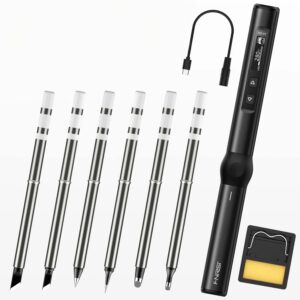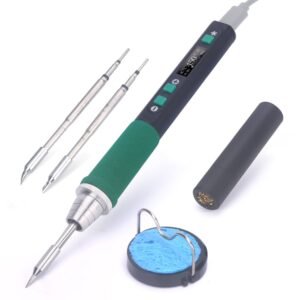Cordless Soldering Iron
Welcome to Kunkune! Here we have cordless soldering irons designed for portability, reliability, and performance.
All YIHUA products come with 12-month guarantee and 60 days return/refund.
Showing all 2 resultsSorted by price: high to low
Showing all 2 resultsSorted by price: high to low
Ready to break free from power outlets and extension cords? A cordless soldering iron might be exactly what you need to take your electronics projects, repairs, and crafts to the next level. When you’re fixing a broken gadget, building a custom circuit, or working on jewelry, these portable powerhouses offer the freedom to work anywhere.
What Makes a Cordless Soldering Iron Special?
Think of a cordless soldering iron as your portable workshop companion. Unlike traditional corded models that chain you to a power outlet, these tools give you the freedom to work anywhere – from tight car engine compartments to outdoor project sites.
Here’s what sets them apart:
A cordless soldering iron operates on battery power, whether that’s a built-in rechargeable battery, removable battery packs, or even gas fuel. This means you can solder connections in places where dragging an extension cord simply isn’t practical.
The technology has come a long way too. Modern cordless soldering irons can reach working temperatures of 300-400°C in under 30 seconds. That’s faster than many corded models from just a few years ago!
Types of Cordless Power Systems
Battery-Powered Models use lithium-ion batteries that you can recharge hundreds of times. They’re perfect for regular use and offer consistent heat output.
USB-C Powered Irons draw power from power banks, laptop chargers, or even your car’s USB port. They’re incredibly versatile and never truly “die” if you have a power bank handy.
Gas-Powered Options use butane fuel and can run for hours without refueling. They’re ideal for heavy-duty work but require proper ventilation.
Cordless vs Corded: Which Should You Choose?
When Cordless Makes Sense:
- You work in tight spaces where cords get in the way
- You need to solder away from power outlets
- You value portability and quick setup
- You do occasional repairs rather than hours of continuous work
When Corded Might Be Better:
- You’re doing production work for hours at a time
- You need precise temperature control for delicate electronics
- You’re working at a fixed workstation
- Budget is your primary concern
Here’s something interesting: many professional repair technicians keep both. They use corded stations for bench work and cordless irons for field repairs. That’s how useful these portable tools have become!
Essential Features That Actually Matter
Battery Performance: The Heart of Your Tool
Battery life isn’t just about runtime – it’s about consistent performance. A good cordless soldering iron should maintain stable temperatures throughout its battery life, not gradually weaken as the battery drains.
Look for models that offer:
- 45+ minutes of continuous use for regular tasks
- Fast charging (under 2 hours for full charge)
- Battery level indicators so you’re never caught off guard
- Replaceable batteries for extended work sessions
Pro tip: If you’re doing lots of soldering, consider getting a model with swappable batteries. You can keep one charging while using another.
Temperature Control: Precision When You Need It
Temperature accuracy separates good cordless irons from great ones. The best models offer:
- Adjustable temperature settings (typically 200-450°C)
- Quick temperature recovery after making a joint
- Digital displays for precise control
- Preset temperature modes for common applications
Why does this matter? Different materials need different temperatures. Electronics components require lower heat (around 300-350°C) while automotive wiring might need 400°C+. Get the temperature wrong, and you could damage sensitive components or create weak joints.
Heat-Up Speed: Get Working Faster
Fast heat-up times are where cordless irons really shine. The best models reach working temperature in:
- Under 15 seconds for professional models
- 15-30 seconds for mid-range options
- 30-60 seconds for budget models
This speed advantage comes from efficient heating elements and smart power management. Some models even have “boost” modes that prioritize reaching temperature quickly.
Tip Compatibility: One Iron, Many Uses
Interchangeable tips multiply your iron’s capabilities. Look for compatibility with popular tip styles:
- Conical tips for precision electronics work
- Chisel tips for through-hole components and wire joining
- Knife tips for dragging across surface-mount components
- Specialty tips for specific applications
Shopping tip: Check if replacement tips are easily available and reasonably priced. Some brands use proprietary tips that cost more to replace.
Top Cordless Soldering Iron Categories
Best for Electronics Work
USB-C powered models dominate this category. They offer:
- Precise temperature control perfect for circuit boards
- Compact size for working in tight spaces
- Power from any USB-C source
- Quick heat-up for efficient workflow
These models typically range from 30-65 watts, which is ideal for electronics repair, prototyping, and component replacement.
Best for Automotive Applications
High-power rechargeable models work best for automotive electrical work:
- Higher wattage (60-100W) for thick wires
- Longer battery life for extended jobs
- Robust construction for workshop environments
- Fast tip recovery for continuous use
When you’re under a car bonnet, the last thing you need is a weak iron that can’t heat heavy gauge wire properly.
Best for Crafts and Jewelry
Precision-focused models excel in detailed work:
- Fine-pointed tips for intricate designs
- Smooth temperature control for delicate materials
- Lightweight design for extended use
- Often include LED work lights
These applications require steady hands and consistent heat – exactly what modern cordless irons deliver.
Budget-Friendly Options
Basic rechargeable models offer excellent value:
- Simple operation without complex controls
- Decent battery life for occasional use
- Standard tip compatibility
- Usually include basic accessories
Don’t let “budget” fool you – these can still deliver professional results for lighter workloads.
Professional Models
High-end cordless irons compete with corded stations:
- Rapid heat-up (under 10 seconds)
- Extended battery life (2+ hours)
- Precise temperature control
- Durable construction for daily use
Real-World Applications
Electronics Repair and Prototyping
Circuit board work requires precision and control. Modern cordless irons excel here because they:
- Won’t accidentally pull components with cord tension
- Provide stable platforms for detailed work
- Heat up quickly for efficient workflow
- Cool down rapidly for safe storage
Have you ever tried to solder a tiny surface-mount component while managing a cord? It’s like trying to perform surgery while tangled in cables!
Automotive Electrical Work
Vehicle repairs showcase cordless advantages:
- Work in engine compartments without extension cords
- No risk of cords getting caught on hot exhaust components
- Portable enough to carry between vehicles
- Powerful enough for heavy-duty automotive wire
Jewelry and Crafts
Artistic applications benefit from cordless freedom:
- Move freely around large pieces
- Work outdoors at craft fairs
- No cord to accidentally drag through your work
- Precise control for delicate materials
Field Repair Applications
On-site repairs are where cordless irons truly shine:
- Telecommunications technicians fixing junction boxes
- Appliance repair in customers’ homes
- Electronic repairs at trade shows
- Emergency fixes away from workshops
Maintenance and Care
Battery Care: Extend Your Tool’s Life
Proper battery maintenance dramatically extends your iron’s lifespan:
Charging habits matter more than you might think. Always use the provided charger, avoid overcharging, and store batteries at partial charge (40-60%) for long-term storage.
Temperature extremes kill batteries faster than heavy use. Don’t leave your iron in a hot car or freezing garage.
Regular use actually helps battery health. Batteries that sit unused for months often lose capacity permanently.
Tip Maintenance: Keep Your Edge Sharp
Clean tips solder better and last longer:
- Wipe tips on a damp sponge between joints
- Use brass wool for stubborn oxidation
- Apply fresh solder to clean tips before storage
- Replace tips when they become pitted or worn
Pro tip: A well-maintained tip can last years with regular use. A neglected tip might need replacing after just a few projects.
Storage Recommendations
Proper storage protects your investment:
- Store in a cool, dry place
- Use protective caps when provided
- Keep batteries partially charged
- Store tips separately to prevent damage
Safety Considerations
Heat Safety: Respect the Temperature
Cordless doesn’t mean careless. These tools reach temperatures that can cause serious burns:
- Always use proper stands when not in use
- Never leave a hot iron unattended
- Keep work areas clear of flammable materials
- Have proper ventilation for solder fumes
Battery Safety: Handle with Care
Lithium batteries require respect:
- Don’t puncture or damage battery cases
- Avoid extreme temperatures
- Use only manufacturer-approved chargers
- Dispose of old batteries properly
Workspace Setup: Create a Safe Environment
Good workspace habits prevent accidents:
- Use proper lighting to see clearly
- Keep a damp sponge nearby for cleaning
- Have a fire extinguisher accessible
- Work in well-ventilated areas
Cost Analysis: Understanding True Value
Initial Investment vs Long-Term Value
Upfront costs vary widely, but consider the total picture:
- Entry-level models (£25-£50) suit occasional use
- Mid-range options (£50-£100) offer better performance and durability
- Professional models (£100+) justify their cost through reliability and features
Operating Costs: The Hidden Expenses
Ongoing expenses include:
- Replacement tips (£5-£20 each, lasting 6-24 months)
- Battery replacements (£20-£50 every 2-5 years)
- Accessories (stands, cases, cleaning supplies)
Think of it like a car – the purchase price is just the beginning. Factor in maintenance costs when making your decision.
When to Upgrade
Consider upgrading when:
- Your current iron takes too long to heat up
- Battery life no longer meets your needs
- You need more precise temperature control
- Your projects have outgrown your current tool’s capabilities
Frequently Asked Questions
Q: How long do batteries typically last? A: Modern lithium-ion batteries usually provide 300-500 charge cycles before noticeable capacity loss. With proper care, expect 2-5 years of regular use.
Q: Can I use any USB-C charger with USB-C powered irons? A: Most models work with standard USB-C PD chargers, but check wattage requirements. Some high-power models need 65W+ chargers for optimal performance.
Q: Are cordless irons suitable for lead-free solder? A: Yes, most modern cordless irons reach the higher temperatures (around 370°C) required for lead-free solder. Check your model’s maximum temperature rating.
Q: How accurate are the temperature displays? A: Quality models are typically accurate within ±5°C. Some budget models may have less precise temperature control.
Q: Can I replace batteries in cordless soldering irons? A: This varies by model. Some have user-replaceable batteries, others require professional service. Check before purchasing if this matters to you.
Your Next Steps
Ready to go cordless? Here’s your action plan:
• Identify your primary use case – electronics, automotive, crafts, or general repair • Set your budget including accessories and ongoing costs • Consider your workspace – do you need extreme portability or just cord-free convenience? • Look for models with good tip availability in your area • Read recent reviews to ensure reliability and performance
The bottom line? A quality cordless soldering iron opens up possibilities that simply aren’t practical with corded models. Whether you’re fixing a smartphone in your living room or working on a car in your driveway, these tools deliver the freedom to work anywhere.
The technology has matured to the point where cordless performance rivals traditional corded irons for most applications. With proper care and the right model for your needs, a cordless soldering iron can serve you reliably for years.
What’s your next project going to be? With a cordless soldering iron in your toolkit, the possibilities are limitless – and completely portable.
Remember: Great tools make great projects possible. Choose wisely, work safely, and enjoy the freedom that comes with cutting the cord.


